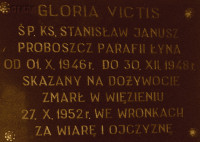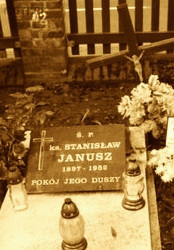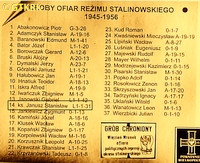Roman Catholic
St Sigismund parish
05-507 Słomczyn
85 Wiślana Str.
Konstancin deanery
Warsaw archdiocese, Poland
full list:
displayClick to display full list

searchClick to search full list by categories
wyświetlKliknij by wyświetlić pełną listę po polsku

szukajKliknij by przeszukać listę wg kategorii po polsku

Martyrology of the clergy — Poland
XX century (1914 – 1989)
personal data

surname
JANUSZ
forename(s)
Stanislav (pl. Stanisław)
function
diocesan priest
creed
Latin (Roman Catholic) Church RCmore on
en.wikipedia.org
[access: 2014.09.21]
diocese / province
Warmia diocesemore on
en.wikipedia.org
[access: 2018.09.02]
Przemyśl diocesemore on
www.przemyska.pl
[access: 2013.02.15]
date and place
of death
27.10.1952

Wronkitoday: Wronki gm., Szamotuły pov., Greater Poland voiv., Poland
more on
en.wikipedia.org
[access: 2021.06.20]
details of death
After end of hostilities of the World War II started by German and Russian invasion of Poland in 09.1939, after start of Russian occupation in 1945, arrested during the night of 02‐03.12.1948 in Olsztyn by the Commie‐Nazi Polish Security Police UB (part of Russian KGB).
Accused of collaboration with the clandestine Freedom and Independence WIN organization (the so‐called „steadfast and cursed soldiers” — both he and other defendants claimed that they had learned about their membership at a court hearing) in Olsztyn and in the village of Łyna, where was a chaplain, intelligence and terrorist activities, collection of information about the functioning of the UB in Olsztyn and passing them on to the organs of the political People’s Party PSL, incitement to store firearms, persuasion to murder the secretary of the Commie‐Nazi PPR party in Łyna, and distribution of anti–communist letters and leaflets.
Subjected to murderous investigation.
Tortured.
Pleaded not guilty.
On 31.08.1949, a court hearing was held in Olsztyn, in which a total of 10 people were tried.
For „an attempt to overthrow the democratic system of the Polish State” and „espionage” — pursuant to Art. 86 §2 of the Penal Code of the Polish Army („whoever attempts to change the system of government of the Polish State by force shall be subject to the penalty of imprisonment for a term of not less than 5 years or the death penalty”) — sentenced to double death penalty. Apart from him two others were sentenced to death.
On 29.11.1949, the Commie‐Nazi Supreme Audit Court upheld the death sentence, stating that „the convicted Janusz Stanislav, who wants to present himself as a true democrat, is in fact an enemy of the Polish People's State, cleverly masking his criminal activities.
He is the most intelligent of all convicted.
He had a great moral influence on them and had great authority among them.
He was acting according to the instructions of the Vatican in the service of imperialism”.
On 24.12.1949, Bolesław Bierut, a Russian agent and traitor, who was appointed by the Russians as the Commie‐Nazi president of the prl — People's Republic of Poland — „exercised the right of grace” and „changed the death penalty into life imprisonment”.
Imprisoned in Olsztyn, Barczewo (from 27.01.1950), Rawicz (from 08.03.1950) and Wronki.
There, from 30.07.1952 held in prison hospital, where perished (formally of „liver cancer”).
cause of death
extermination: exhaustion
perpetrators
Russians / Poles
sites and events
WronkiClick to display the description, RawiczClick to display the description, Ribbentrop‐MolotovClick to display the description, Pius XI's encyclicalsClick to display the description
date and place
of birth
29.04.1897

Domaradztoday: Domaradz gm., Brzozów pov., Subcarpathia voiv., Poland
more on
en.wikipedia.org
[access: 2021.10.09]
parents
JANUSZ Joseph
🞲 ?, ? — 🕆 ?, ?

HERBUT Marianne
🞲 ?, ? — 🕆 ?, ?
baptism
30.04.1897

Domaradztoday: Domaradz gm., Brzozów pov., Subcarpathia voiv., Poland
more on
en.wikipedia.org
[access: 2021.10.09]
St Nicholas the Bishop and Confessor RC church
presbyter (holy orders)
ordination
11.06.1922

Przemyśltoday: Przemyśl city pov., Subcarpathia voiv., Poland
more on
en.wikipedia.org
[access: 2021.04.01]
Assumption of the Blessed Virgin Mary and St John the Baptist RC cathedral churchmore on
en.wikipedia.org
[access: 2025.03.14]
positions held
1946 – 1948
administrator — Łynatoday: Nidzica gm., Nidzica pov., Warmia‐Masuria voiv., Poland
more on
en.wikipedia.org
[access: 2021.10.09] ⋄ Immaculate Heart of the Blessed Virgin Mary RC church — minister of the branch churches Szkotowo, Turowo, Dziurdziewo, Waplewo, Stębark, Żelazna
from 07.03.1947
tertiary — Dominicans OP
1945 – 1946
vicar — Olsztyntoday: Olsztyn city pov., Warmia‐Masuria voiv., Poland
more on
en.wikipedia.org
[access: 2022.01.28] ⋄ Sacred Heart of Jesus RC parish ⋄ Olsztyntoday: Olsztyn city pov., Warmia‐Masuria voiv., Poland
more on
en.wikipedia.org
[access: 2022.01.28] RC deanery — also: prefect of secondary schools
c. 1945
resident — OlsztynZatorze district
today: Olsztyn city pov., Warmia‐Masuria voiv., Poland
more on
en.wikipedia.org
[access: 2022.01.28] ⋄ St Joseph RC parish ⋄ Olsztyntoday: Olsztyn city pov., Warmia‐Masuria voiv., Poland
more on
en.wikipedia.org
[access: 2022.01.28] RC deanery
1944
administrator — Futomatoday: Błażowa gm., Rzeszów pov., Subcarpathia voiv., Poland
more on
en.wikipedia.org
[access: 2021.10.09] ⋄ St Leonard the Confessor, St Michael the Archangel, St Adalbert the Bishop and Martyr and St Valentine the Martyr RC parish ⋄ Dynówtoday: Dynów urban gm., Rzeszów pov., Subcarpathia voiv., Poland
more on
en.wikipedia.org
[access: 2021.10.09] RC deanery — acting („ad interim”)
1937 – 1944
resident — Domaradztoday: Domaradz gm., Brzozów pov., Subcarpathia voiv., Poland
more on
en.wikipedia.org
[access: 2021.10.09] ⋄ St Nicholas the Bishop and Confessor RC parish ⋄ Brzozówtoday: Brzozów gm., Brzozów pov., Subcarpathia voiv., Poland
more on
en.wikipedia.org
[access: 2021.10.09] RC deanery
c. 1937
resident — Kalwaria Pacławskatoday: Fredropol gm., Przemyśl pov., Subcarpathia voiv., Poland
more on
en.wikipedia.org
[access: 2021.10.09] ⋄ Exaltation of the Holy Cross RC parish ⋄ Dobromyltoday: Dobromyl urban hrom., Sambir rai., Lviv obl., Ukraine
more on
en.wikipedia.org
[access: 2021.10.09] RC deanery
1936
vicar — Pysznicatoday: Pysznica gm., Stalowa Wola pov., Subcarpathia voiv., Poland
more on
en.wikipedia.org
[access: 2021.10.09] ⋄ Exaltation of the Holy Cross RC parish ⋄ Ulanówtoday: Ulanów gm., Nisko pov., Subcarpathia voiv., Poland
more on
en.wikipedia.org
[access: 2020.11.27] RC deanery
1935 – 1936
vicar — Racławicetoday: Nisko gm., Nisko pov., Subcarpathia voiv., Poland
more on
en.wikipedia.org
[access: 2021.10.09] ⋄ St Stanislav the Bishop and Martyr RC parish
1935
vicar — Dublianytoday: Novyi Kalyniv urban hrom., Sambir rai., Lviv obl., Ukraine
more on
en.wikipedia.org
[access: 2021.10.09] ⋄ St Nicholas the Bishop and Confessor RC parish ⋄ Drohobychtoday: Drohobych urban hrom., Drohobych rai., Lviv obl., Ukraine
more on
en.wikipedia.org
[access: 2021.10.09] RC deanery
1935
vicar — Dzikowiectoday: Dzikowiec gm., Kolbuszowa pov., Subcarpathia voiv., Poland
more on
en.wikipedia.org
[access: 2022.04.12] ⋄ St Nicholas the Bishop and Confessor RC parish
1933 – 1935
vicar — Leżajsktoday: Leżajsk urban gm., Leżajsk pov., Subcarpathia voiv., Poland
more on
en.wikipedia.org
[access: 2021.10.09] ⋄ Holy Trinity, Blessed Virgin Mary and All the Saints RC parish ⋄ Leżajsktoday: Leżajsk urban gm., Leżajsk pov., Subcarpathia voiv., Poland
more on
en.wikipedia.org
[access: 2021.10.09] RC deanery
1931 – 1933
vicar — Sudova Vyshnyatoday: Sudova Vyshnya urban hrom., Yavoriv rai., Lviv obl., Ukraine
more on
en.wikipedia.org
[access: 2021.05.06] ⋄ Blessed Virgin Mary Help of Christians RC parish ⋄ Sudova Vyshnyatoday: Sudova Vyshnya urban hrom., Yavoriv rai., Lviv obl., Ukraine
more on
en.wikipedia.org
[access: 2021.05.06] RC deanery
1929 – 1931
vicar — Hyżne Rzeszowskietoday: Hyżne, Hyżne gm., Rzeszów pov., Subcarpathia voiv., Poland
more on
en.wikipedia.org
[access: 2021.10.09] ⋄ Nativity of the Blessed Virgin Mary RC parish ⋄ Tyczyntoday: Tyczyn gm., Rzeszów pov., Subcarpathia voiv., Poland
more on
en.wikipedia.org
[access: 2021.05.06] RC deanery
1928 – 1929
administrator — Kramarzówkatoday: Pruchnik gm., Jarosław pov., Subcarpathia voiv., Poland
more on
en.wikipedia.org
[access: 2021.10.09] ⋄ St Clement the Pope RC parish ⋄ Pruchniktoday: Pruchnik gm., Jarosław pov., Subcarpathia voiv., Poland
more on
en.wikipedia.org
[access: 2021.10.09] RC deanery
1926 – 1928
vicar — Pruchniktoday: Pruchnik gm., Jarosław pov., Subcarpathia voiv., Poland
more on
en.wikipedia.org
[access: 2021.10.09] ⋄ St Nicholas the Bishop and Confessor RC parish ⋄ Pruchniktoday: Pruchnik gm., Jarosław pov., Subcarpathia voiv., Poland
more on
en.wikipedia.org
[access: 2021.10.09] RC deanery
1924 – 1925
curatus/rector/expositus — Posada Olchowskatoday: Posada, district of Sanok, Sanok urban gm., Sanok pov., Subcarpathia voiv., Poland
more on
en.wikipedia.org
[access: 2021.10.09] ⋄ RC church ⋄ Sanoktoday: Sanok urban gm., Sanok pov., Subcarpathia voiv., Poland
more on
en.wikipedia.org
[access: 2021.10.09], Transfiguration of the Lord RC parish ⋄ Sanoktoday: Sanok urban gm., Sanok pov., Subcarpathia voiv., Poland
more on
en.wikipedia.org
[access: 2021.10.09] RC deanery
1923 – 1924
vicar — Sanoktoday: Sanok urban gm., Sanok pov., Subcarpathia voiv., Poland
more on
en.wikipedia.org
[access: 2021.10.09] ⋄ Transfiguration of the Lord RC parish ⋄ Sanoktoday: Sanok urban gm., Sanok pov., Subcarpathia voiv., Poland
more on
en.wikipedia.org
[access: 2021.10.09] RC deanery — also: prison chaplain
1922 – 1923
vicar — Dylągowatoday: Dynów gm., Rzeszów pov., Subcarpathia voiv., Poland
more on
en.wikipedia.org
[access: 2021.12.18] ⋄ St Sophie the Virgin and Martyr RC parish
1918 – 1922
student — Przemyśltoday: Przemyśl city pov., Subcarpathia voiv., Poland
more on
en.wikipedia.org
[access: 2021.04.01] ⋄ philosophy and theology, Theological Seminary
sites and events
descriptions
Wronki: Penal prison in 1939‐1945 managed by the Germans — called Strafgefüngnis Wronki — for the prisoners sentenced to 6 months to 2 years incarceration, mainly Poles. Altogether up to 28,000 inmates were held there. After 1945 it was a jail for political prisoners, „enemies” of Russian‐Polish Commie‐Nazis. (more on: www.sw.gov.plClick to attempt to display webpage
[access: 2013.08.17], pl.wikipedia.orgClick to attempt to display webpage
[access: 2013.08.17])
Rawicz: Prison, founded in 1819‐1821, in place of the Franciscan Friars Minor's monastery, which was liquidated by the Prussian occupation authorities. During the World War II, during the German occupation of 1939‐1945, the German Germ. Zuchthaus (Eng. heavy prison), intended for men sentenced to long‐term imprisonment and penal camp sentences, levied mainly by the Germ. Warthegau (Eng. Wartha region) occupation courts. A large part of the prisoners were next transported from there to German concentration camps. After the end of the military operations of World War II, the prison was managed by the Commie‐Nazi authorities of the Russian prl republic. Many activists of the Polish clandestine independence underground were detained there, including soldiers of the Home Army AK. Political prisoners were finally released in 1956. (more on: pl.wikipedia.orgClick to attempt to display webpage
[access: 2013.08.17])
Ribbentrop‐Molotov: Genocidal Russian‐German alliance pact between Russian leader Joseph Stalin and German leader Adolf Hitler signed on 23.08.1939 in Moscow by respective foreign ministers, Mr. Vyacheslav Molotov for Russia and Joachim von Ribbentrop for Germany. The pact sanctioned and was the direct cause of joint Russian and German invasion of Poland and the outbreak of the World War II in 09.1939. In a political sense, the pact was an attempt to restore the status quo ante before 1914, with one exception, namely the „commercial” exchange of the so‐called „Kingdom of Poland”, which in 1914 was part of the Russian Empire, fore Eastern Galicia (today's western Ukraine), in 1914 belonging to the Austro‐Hungarian Empire. Galicia, including Lviv, was to be taken over by the Russians, the „Kingdom of Poland” — under the name of the General Governorate — Germany. The resultant „war was one of the greatest calamities and dramas of humanity in history, for two atheistic and anti‐Christian ideologies — national and international socialism — rejected God and His fifth Decalogue commandment: Thou shall not kill!” (Abp Stanislav Gądecki, 01.09.2019). The decisions taken — backed up by the betrayal of the formal allies of Poland, France and Germany, which on 12.09.1939, at a joint conference in Abbeville, decided not to provide aid to attacked Poland and not to take military action against Germany (a clear breach of treaty obligations with Poland) — were on 28.09.1939 slightly altered and made more precise when a treaty on „German‐Russian boundaries and friendship” was agreed by the same murderous signatories. One of its findings was establishment of spheres of influence in Central and Eastern Europe and in consequence IV partition of Poland. In one of its secret annexes agreed, that: „the Signatories will not tolerate on its respective territories any Polish propaganda that affects the territory of the other Side. On their respective territories they will suppress all such propaganda and inform each other of the measures taken to accomplish it”. The agreements resulted in a series of meeting between two genocidal organization representing both sides — German Gestapo and Russian NKVD when coordination of efforts to exterminate Polish intelligentsia and Polish leading classes (in Germany called «Intelligenzaktion», in Russia took the form of Katyń massacres) where discussed. Resulted in deaths of hundreds of thousands of Polish intelligentsia, including thousands of priests presented here, and tens of millions of ordinary people,. The results of this Russian‐German pact lasted till 1989 and are still in evidence even today. (more on: en.wikipedia.orgClick to attempt to display webpage
[access: 2015.09.30])
Pius XI's encyclicals: Facing the creation of two totalitarian systems in Europe, which seemed to compete with each other, though there were more similarities than contradictions between them, Pope Pius XI issued in 03.1937 (within 5 days) two encyclicals. In the „Mit brennender Sorge” (Eng. „With Burning Concern”) published on 14.03.1938, condemned the national socialism prevailing in Germany. The Pope wrote: „Whoever, following the old Germanic‐pre‐Christian beliefs, puts various impersonal fate in the place of a personal God, denies the wisdom of God and Providence […], whoever exalts earthly values: race or nation, or state, or state system, representatives of state power or other fundamental values of human society, […] and makes them the highest standard of all values, including religious ones, and idolizes them, this one […] is far from true faith in God and from a worldview corresponding to such faith”. On 19.03.1937, published „Divini Redemptoris” (Eng. „Divine Redeemer”), in which criticized Russian communism, dialectical materialism and the class struggle theory. The Pope wrote: „Communism deprives man of freedom, and therefore the spiritual basis of all life norms. It deprives the human person of all his dignity and any moral support with which he could resist the onslaught of blind passions […] This is the new gospel that Bolshevik and godless communism preaches as a message of salvation and redemption of humanity”… Pius XI demanded that the established human law be subjected to the natural law of God , recommended the implementation of the ideal of a Christian state and society, and called on Catholics to resist. Two years later, National Socialist Germany and Communist Russia came together and started World War II. (more on: www.vatican.vaClick to attempt to display webpage
[access: 2023.05.28], www.vatican.vaClick to attempt to display webpage
[access: 2023.05.28])
sources
personal:
www.katolicy.euClick to attempt to display webpage
[access: 2021.12.19]
original images:
www.slady.ipn.gov.plClick to attempt to display webpage
[access: 2014.08.14], www.wronki.plClick to attempt to display webpage
[access: 2018.09.02], poznan.uw.gov.plClick to attempt to display webpage
[access: 2025.02.22]
LETTER to CUSTODIAN/ADMINISTRATOR
If you have an Email client on your communicator/computer — such as Mozilla Thunderbird, Windows Mail or Microsoft Outlook, described at WikipediaPatrz:
en.wikipedia.org, among others — try the link below, please:
LETTER to CUSTODIAN/ADMINISTRATORClick and try to call your own Email client
If however you do not run such a client or the above link is not active please send an email to the Custodian/Administrator using your account — in your customary email/correspondence engine — at the following address:

giving the following as the subject:
MARTYROLOGY: JANUSZ Stanislav
To return to the biography press below:
 Click to return to biography
Click to return to biography










